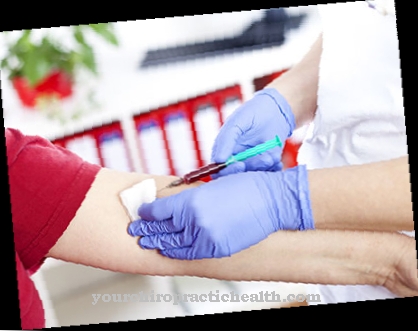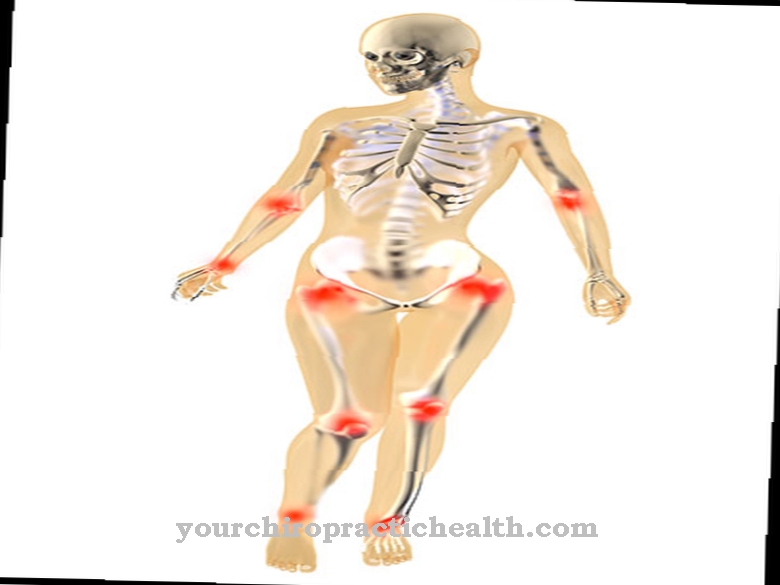Dermatitis herpetiformis Duhring is a chronic skin disease. It is characterized by the formation of blisters on various parts of the body and is accompanied by severe itching. Many patients with Duhring's disease suffer from the inflammatory small bowel disease celiac disease. Dermatitis herpetiformis Duhring is the skin manifestation of this clinical picture. Certain ointments and lotions and a lifelong diet can be used for therapy.
What is Duhring Herpetiform Dermatitis?

© lial88 - stock.adobe.com
Dermatitis herpetiformis Duhring or Duhring's disease is a chronic skin disorder. Blistering on the inside of the arms and legs is characteristic of the clinical picture. The disease is rather rare.
It occurs more frequently in middle age. Men are affected more frequently than women. The disease is chronic. Your symptoms can keep coming up. In many cases, the intensity of the symptoms diminishes over the years.
causes
The causes of the disease are not yet fully understood. A genetic predisposition cannot be ruled out. The disease can be triggered by iodine or gluten. People who suffer from this skin condition should definitely be tested for celiac disease, as these two diseases are associated with each other.
Celiac disease, also known as gluten-induced enteropathy, is an intolerance to the gluten in various types of grain. Those affected show characteristics of an autoimmune disease and an allergy. The consumption of gluten causes chronic inflammation of the mucous membrane in the small intestine. This hypersensitivity reaction lasts for life. Dermatitis herpetisformis Duhring is the skin manifestation of the disease.
Symptoms, ailments and signs
At the beginning, many sufferers develop hives-like rashes. The sick complain of severe itching on the affected areas of the skin. In addition, clearly recognizable reddening of the skin is typical for the clinical picture.
Bubbles gradually form on the reddened areas of the skin. These can spread to neighboring skin tissue and form crusts. The nodules on the surface of the skin are a few millimeters wide and develop into the blisters characteristic of the skin disease after about seven to ten days.
Typical areas of the body where blisters form are the abdomen, thighs, the extensor sides of both arms, the buttocks, sacrum and shoulder girdle. Blistering of the mucous membranes is rarely observed. In only a few cases the neck, back or face are affected.
The bubbles initially have a clear, later cloudy content and can be filled with blood. The sensitive reaction to the trace element iodine is characteristic of the disease. In most cases, exposure to iodine leads to a drastic worsening of symptoms. In addition, the patients who suffer from dermatitis herpetiformis Duhring have celiac disease. This can be asymptomatic or with the appearance of increased fat stools.
diagnosis
Due to the rather unspecific symptoms, especially at the beginning of the disease, Duhring's dermatitis herpetiformis is often recognized late. In order to establish a diagnosis, diseases that have a similar course must first be ruled out. These include the so-called erythema exudativum multiforme.
This disease describes an inflammation of the dermis. To confirm the diagnosis of dermatitis herpetiformis Duhring, a biopsy is made in healthy skin tissue. In order to be able to make the diagnosis with certainty, evidence of so-called granular IgA deposits is necessary. The tissue removed for this must be examined in a special laboratory.
Since many patients who suffer from Duhring's disease also have celiac disease, a diagnosis of this clinical picture must also be carried out. To do this, certain antibodies are determined in the blood. In addition to the detection of gliadin and endomysium antibodies, the patients are examined for transglutaminase IgA antibodies.
In addition, a biopsy of the small intestine must be performed to confirm the diagnosis. Most patients with Duhring's disease show a rather harmless course of celiac disease. However, a few can experience massive fatty stools, osteoporosis, and vitamin deficiencies.
Complications
Dermatitis herpetiformis Duhring is a rarely occurring incurable autoimmune skin disease. The symptom is not age-related and makes men more ill than women. In Scandinavia, Hungary, England and Ireland in particular, the disease occurs more often than in Germany.
Therefore, there is a suspicion that Duhring's dermatitis herpetiformis is an inherited disease. Furthermore, there may be a connection with intestinal diseases due to gluten intolerance. In addition, tumor formation as well as infections and contact with iodine seem to promote the symptom.
Dermatitis herpetiformis Duhring starts with reddened skin. If the person concerned ignores the symptom or treats it incorrectly on their own initiative, painful swellings and unpleasant itching develop. The symptom affects the limbs, but also appears on the head, upper body, sacrum and buttocks, but very rarely on the mucous membranes. As a real complication, the affected areas become inflamed and form abscesses.
These enlarge into fluid-filled skin blisters. The blisters become encrusted due to the increasing, burning itching. The course develops chronically. With timely medical clarification, complications can be largely excluded. A lifelong gluten-free diet is recommended in medical therapy. Medicines based on sulfone or cortisone as well as lotions are administered as tolerated.
When should you go to the doctor?
In the case of hives-like rashes and other signs of dermatitis herpetiformis Duhring, a visit to your doctor is recommended. Reddening of the skin, severe itching and blisters are also symptoms that indicate a serious skin disease and must be investigated accordingly. If swelling and abscesses develop as a result of incorrect or inadequate treatment, it is best to go to the nearest clinic. This is especially true if the bubbles fill or crust with liquid.
If it is chronic, regular visits to the doctor are indicated, which is why the disease is best diagnosed and treated at an early stage. Dermatitis herpetiformis Duhring is particularly common after a tumor, infection and contact with iodine.
If these factors apply to you, you should consult a doctor immediately with the symptoms mentioned. In addition to the family doctor, the dermatologist or a specialist in internal medicine can also be contacted. In the event of medical emergencies - for example if sepsis develops or heavy bleeding occurs - the medical emergency service is the right contact.
Doctors & therapists in your area
Treatment & Therapy
The itchy regions of the skin are usually treated with the sulfone dapsone. As a rule, most patients are symptom-free within a short time after this application. Dapsone can have side effects. Therapy should therefore be supported by regular blood tests.
Since iodine can worsen the disease, foods rich in iodine should be avoided, especially at the beginning. These include certain types of sea fish. The affected skin areas and the itching can also be treated with soothing ointments or lotions. In some cases, short-term treatment with cortisone preparations is induced. Long-term special care of the skin is not necessary for dermatitis herpetiformis Duhring.
Since Duhring's dermatitis herpetiformis is based on celiac disease, this disease must be treated with the same therapy. For those affected, this means doing without the adhesive protein gluten for a lifetime. Even the smallest amounts can drastically worsen the course of the disease.
Gluten is the gluten protein of certain types of grain. The sick therefore have to do without the grains wheat, rye, barley, spelled, kamut, einkorn, emmer and green spelled. Products made from these products such as couscous or pasta must also be left out. Corn, millet, rice, quinoa, soy and buckwheat are expressly permitted. Products that do not contain gluten are labeled with the addition “gluten-free” and can be consumed without hesitation.
Outlook & forecast
With a consistent change in diet, patients with dermatitis herpetiformis Duhring have a good prognosis. In many cases, further medical care is usually not necessary. In the case of more severe symptoms, herbs help to relieve the changes in the skin or the itching. However, these are associated with side effects. Regular blood tests are therefore advisable in order not to trigger any further illnesses.
The patient can achieve a lifelong freedom from symptoms of dermatitis herpetiformis Duhring on their own initiative. To do this, check the food intake. All food must be gluten free to get a good prognosis. In order to have a favorable healing prospect, no product may be consumed that contains even the smallest amounts of gluten. The body needs a few months to a year to be completely gluten-free for recovery.
The symptoms relapse immediately if gluten was consumed. Therefore, there is always the risk of experiencing a recurrence of the symptoms in the course of life. There is an increased risk, especially when eating food in restaurants. Without giving up gluten, the patient can fall victim to a chronic disease process. The general state of health is weakened and the susceptibility to disease is greatly increased. The quality of life decreases and health conditions become much more difficult in everyday life.
prevention
Prevention of the disease is only possible to a limited extent. Since Duhring's dermatitis herpetiformis is associated with celiac disease and high exposure to iodine, it is conceivable that a lifelong special diet could reduce the likelihood of the skin disease.
Aftercare
With dermatitis herpetiformis Duhring, there are usually no special options or measures available for follow-up care. The affected person is primarily dependent on full medical treatment in order to alleviate the symptoms and avoid further complications, as this cannot lead to an independent healing.
Only through early diagnosis and rapid treatment can a worsening of the symptoms be avoided. In most cases, Duhring's dermatitis herpetiformis is treated with the help of medication, ointments or creams. The affected person should always pay attention to the doctor's instructions and also observe the regularity and dosage of the medication.
If you have any questions or are unclear, a doctor should always be contacted first. If the symptoms of dermatitis herpetiformis Duhring do not go away within a few days, a doctor should definitely be consulted. Since the illness can also lead to mental upsets or depression, intensive discussions with friends or with your own family are often very useful. In serious cases, however, professional advice from a psychologist is useful. As a rule, Duhring herpetiform dermatitis does not reduce the patient's life expectancy.
You can do that yourself
Despite the difficult diagnosis, everyone can do a few things to improve their quality of life. Self-discipline is important as the symptom of itching should not be indulged in. Scratching leads to open wounds that germs can penetrate. In addition, the skin damage increases. For his own sake, the person concerned should therefore make sure that he uses ointments if the itching is too strong and therefore not tempted.
The skin changes lead to an optical flaw. This can reduce self-esteem. It is advisable to obtain comprehensive information about the disease and to find ways to maintain the patient's aesthetic standards. Discussions and tips with other sick people or close relatives often help.
It can be helpful to find out their attitude and perception of the skin changes. In many cases, the person concerned feels the visual flaw themselves worse than it is seen by the immediate environment. Changing cognitive patterns can therefore alleviate emotional distress.
Although it has not yet been adequately researched scientifically, it seems that a special diet may be beneficial for one's own recovery. This must take place for life and can contribute to a significant improvement in symptoms and an increase in your own well-being.

.jpg)



.jpg)





















